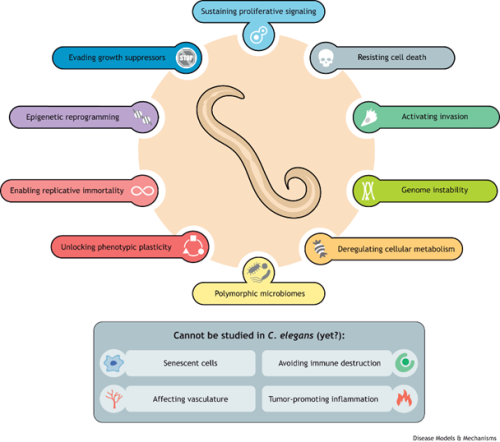‘Worming up’ disease research
Posted by Jason Higgins, on 21 July 2023
In recognition of the Genetics Society of America 24th International C. elegans Conference at the end of June 2023, Disease Models & Mechanisms (DMM) celebrated worm research with specially commissioned open-access articles, including an Editorial from DMM Editorial Board member Guy Caldwell, an interview with Piali Sengupta and a Review from Julián Cerón. The GSA worm meeting was exuberantly welcomed by the C. elegans community, who had been deprived of an in-person meeting since 2019. The meeting was kicked off with a plenary session that was sponsored by DMM and included a fantastic talk from Julie Ahringer on how the genome directs development. The engaging plenary and break-out sessions journeyed through a wide range of topics from genomics and epigenetics to the cytoskeleton and intracellular trafficking, to metabolism and neuronal cell biology, many in the context of development and human disease. The attendees were entranced by a keynote address from Oliver Hobert, aptly titled ‘Why C. elegans remains special’, and many whole-heartedly embraced the Scottish Ceilidh dancing at the conference dinner. The conference maintained an energic buzz throughout, with animated discussions following speaker sessions and clustered around the posters. It was wrapped up with a thought-provoking ‘Inclusivity Session’ led by organiser Miriam Goodman and others, and in the closing remarks organiser Sander van den Heuvel left us with the fitting statement that C. elegans is “not just a model system, but a pioneering system”.
Sander’s comments, along with the energy at GSA worm, echoed Guy Caldwell’s editorial that highlighted the model organism as a robust and translational model of disease. Guy discussed advances in genomic data and the progress of the model over the past 15 years, highlighting the power of genetic screens and CRISPR gene editing. He expanded by stating that the use of this technology in cell-based or invertebrate models have not been supplanted but are instead joined by voluminous datasets of human genomic variation. C. elegans researchers are now increasingly able to face the staggering task of parsing function from human disease-associated variants. Away from genetic screening, Guy continues by highlighting that C. elegans studies have also been applied to deep phenotyping, where research has provided a higher level of detail of disease characterisation.

DMM’s focus on C. elegans also featured ‘See[ing] elegance in sensory biology: an interview with Piali Sengupta’. Piali is a prominent researcher in the field of sensory biology and in this interview emphasises the use of C. elegans in neurology, stating that the model is ideal to assess the role of specific neurons in behaviour. She also states that, “Forward genetic screens are also very easy because most of the worm population in the lab are hermaphrodites. If you have a mutant hermaphrodite, you just put it on a plate, and it reproduces”

“You can kill most neurons in the worm, and they will normally survive in the lab”, Piali Sengupta
The final piece of literature that DMM included in this C. elegans focus, was a review by Julián Cerón; ‘Caenorhabditis elegans for research on Cancer hallmarks’. Julián emphasises the use of C. elegans as a robust translational model of cancer that can recapitulate ten of the major hallmarks of cancer. Julián emphasises how C. elegans can be used to study hallmarks ranging from the regulation of apoptosis to the activation of invasion.

DMM is honoured to support the C. elegans community by publishing cutting-edge science that provides mechanistic and translational insights to benefit human health and welcome your next C. elegans paper to wriggle into their dedicated collection. We hope you enjoyed #Worm23 and we look forward to the next C. elegans conference in 2025!


 (No Ratings Yet)
(No Ratings Yet)